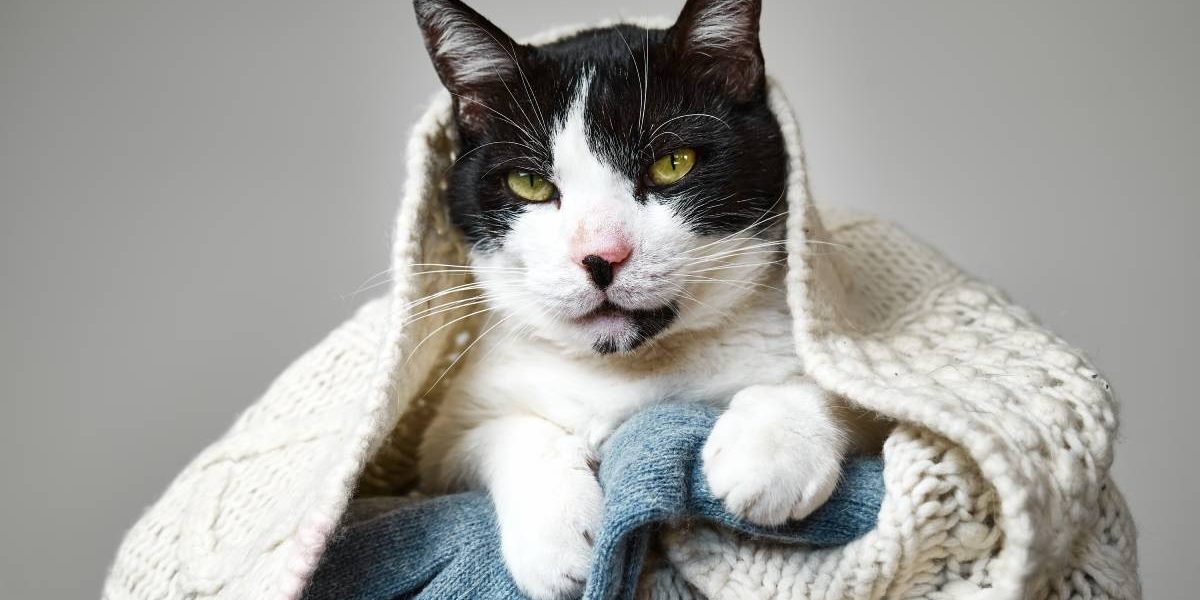Cats are known for their independent and mysterious nature, often leaving their owners wondering how they truly feel about the world around them. When it comes to temperature many pet owners may not realize that their feline friends can get cold too.
While cats are generally good at regulating their body temperature they’re not invincible to chilly weather or air conditioned spaces.
But how do you know if your cat is cold? What are the signs to look out for and how can you make sure your cat stays comfortable in varying temperatures?
This article will explore these questions helping you better understand your cat’s needs and how to keep them warm during colder months or in air conditioned environments.
Signs Your Cat May Be Cold
Curling Up in a Ball
One of the most common signs that your cat is feeling cold is when they curl up into a tight ball. Cats naturally curl into a ball to preserve body heat especially when they are in a colder environment.
When they do this they’re likely trying to conserve warmth by reducing the surface area of their bodies exposed to the cold air.
Seeking Warmth
If your cat is constantly seeking out warm spots like near a heater, under a blanket, or even on your lap it’s a good indication they are trying to stay warm.
Cats may gravitate toward areas where there’s heat whether it’s a sunny spot by a window a soft blanket or even a cozy spot near other pets or humans. If they’re actively seeking warmth it’s a sign that they may be too cold.
Shivering or Trembling
While not as common in cats as it is in humans shivering or trembling can be a sign that your cat is too cold.
If your cat starts to shake uncontrollably, it’s time to check the temperature of their surroundings. Shivering is an involuntary response to cold, and while it can also happen from anxiety or stress if it’s in conjunction with other signs of being cold it’s likely a temperature issue.
Hiding More Than Usual
Cats have a tendency to seek out safe quiet places to rest but if your cat is hiding more often it could be an indication that they’re uncomfortable due to the cold.
Cats may try to find an insulated or hidden spot to keep themselves warm if they’re feeling chilly. If they’re hiding in places they don’t usually go it might be worth checking if the room temperature is too low.
Lethargy and Reduced Activity
Cold temperatures can make cats sluggish as they conserve energy to stay warm. If your cat is less active than usual it may be due to the col but lethargy can also indicate illness so monitor other behaviors for clarity.
How Cold Is Too Cold for Cats?
Cats can handle cold but there are limits. The ideal temperature for most cats is between 60°F to 80°F. Below 45°F can cause discomfort and below freezing is dangerous.
Some breeds like Siberian or Maine Coon handle cold better while short haired or hairless breeds like Sphynx are more sensitive. Prolonged exposure to cold below 45°F can cause hypothermia with symptoms like:
- Weakness
- Shivering
- Slow heart rate
- Stiff muscles
- Dilated pupils
- Difficulty breathing
If you notice any of these signs in your cat, it’s important to take them to a vet immediately. Keeping your cat warm and safe from cold drafts is essential to their health and comfort.
Do Cats Get Cold in AC?
Although cats are warm blooded they don’t tolerate cold the same way humans do. They can feel cold in air conditioned environments especially if the temperature is set too low.
Cats are more sensitive to sudden temperature changes, and extreme cold from air conditioning can make them uncomfortable.
Air Conditioning Can Dry Out Their Skin and Fur
Air conditioning not only lowers the temperature but can also cause dryness. The cool, dry air can dehydrate your cat’s skin and fur which can cause discomfort.
If your cat’s skin becomes too dry it could result in itchy or flaky skin, making them more likely to curl up in search of warmth.
Cats Can Get Chilled from AC Drafts
If the air conditioning is blowing directly on your cat it can cause them to become chilled. Unlike dogs who might shake or visibly react to being too cold cats are generally less vocal about being uncomfortable.
Cats Don’t Sweat Like Humans
While humans sweat to regulate body temperature, cats do not sweat like we do. Instead they rely on their fur and other mechanisms to keep themselves warm or cool.
When exposed to cold air from an AC unit they can’t regulate their body temperature as efficiently as we can making them more susceptible to feeling cold.
Provide warm spaces
Make sure your cat has a cozy spot where they can retreat if the air conditioning gets too cold. You can use soft blankets or heated cat beds to provide warmth.
Monitor the temperature
Set the AC to a comfortable temperature range. Ideally, you want to keep the temperature between 65°F to 75°F for your cat’s comfort.
Use a fan or humidifier
If the air conditioning is making the air too dry, consider using a fan or humidifier in the room to add some moisture back into the air.
How to Keep Your Cat Warm in Cold Weather
If you’re concerned that your cat is cold during the colder months or in air conditioned spaces there are several steps you can take to help keep them warm and comfortable:
Create Cozy Spaces
Make sure your cat has access to warm comfortable places to rest. You can use heated cat beds soft blankets or even a heated pad designed specifically for pets to create a cozy retreat.
Dress Your Cat
Some cats especially hairless breeds like the Sphynx, benefit from wearing a sweater or jacket in colder weather.
There are specially designed cat clothes available that can help them stay warm without restricting their movement.
Keep Your Home Warm
If you’re using air conditioning ensure the temperature isn’t set too low especially if you have a cat with a thin coat. You can also close off drafts by sealing windows or using curtains to block out cold air.
Consider a Cat Heater
If you live in an area with extremely cold winters you may want to invest in a cat safe heater to ensure your cat stays warm when they’re not snuggling up to you. Just make sure the heater is placed safely so it doesn’t pose a fire risk.
No Bathing Your Cat
One of the important things to note is not to bathe your cat in cold weather unless absolutely necessary. Bathing a cat can make them cold and stressed. It’s best to avoid it during the colder months as the process of drying off can take a while and can lead to them becoming chilled.
Conclusion
Cats can regulate their body temperature but may still feel cold in chilly environments. Signs like seeking warmth shivering and reduced activity can indicate they’re too cold.
If temperatures drop below 45°F take action to keep them warm such as providing blankets or a heated bed. In air conditioned areas monitor the temperature and provide cozy spots to keep them comfortable.
Ensuring your cat isn’t too cold contributes to their health and happiness and helps prevent issues like hypothermia. Regularly checking your cat’s comfort can also help detect early signs of distress or illness.











